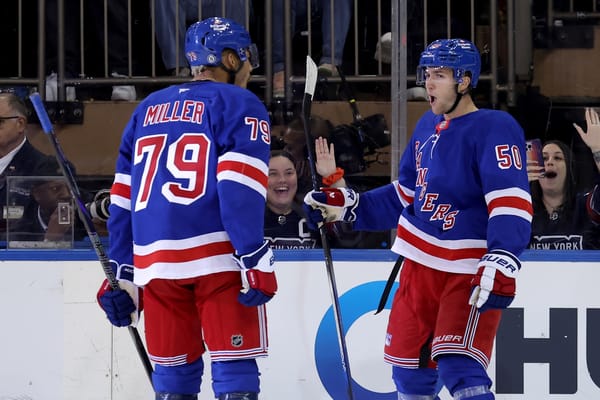Thoughts on Kevin Shattenkirk’s Buyout and What Rangers Could Have Done Differently
The New York Rangers have had a tremendous string of months since announcing their intentions to rebuild in February of 2018. Along the way they have hit a lot of the right notes, especially since being awarded the second overall pick in the draft lottery. But the soon-to-be official buyout of Kevin Shattenkirk is a move that’s a major misstep.
There is no denying that Shattenkirk became a bit redundant on a roster that should feature Jacob Trouba, Tony DeAngelo, and Adam Fox on the right side. However, the Rangers will likely regret not giving him the opportunity to try and play the left side; something Marc Staal hasn’t been able to do effectively for quite some time, and Brendan Smith has struggled to do enough that he’s spent time in Hartford and played forward.
The 2019-20 season is another year in the “build” for the Blueshirts, and in many ways it is going to be a year of experimentation. The Rangers could have afforded to try things out for a year, and moved on from Shattenkirk next offseason when the veteran defender entered the final year of his deal.
Although his cap hit would have been $6.65 million for the season, Shattenkirk would have collected a $2 million bonus on July 1, 2020, and then been owed just $2 million for the duration of the season. Given the low salary for just a season, odds are there would have been multiple teams willing to acquire him; especially if the Rangers’ retained 50 percent of his deal.
Shattenkirk’s reputation around the league prior to signing with the Rangers in July of 2017 was as an offensive defenseman and a power-play wizard.
While that was true with the Rangers, it wasn’t to the extent that could have been hoped. Shattenkirk defended better than most gave him credit for, but his offense didn’t reach the same level, particularly once he lost his spot on the first power play unit. But coming into 2019-20 healthy and in better shape than the year prior, coming off a torn meniscus that cut his first Rangers season in half, there was reason to believe the 30-year-old would be able to regain his stride and continue to evolve his game to adapt to the blue line that’s undergone a number of changes since he first signed in New York.
Things went pretty well overall for Shattenkirk in 2018-19 in what many considered a down year coming off an injury-shortened 2017-18 campaign.
In terms of driving play, Shattenkirk led the defense with a CF% of 49.59, was the only defender with a positive shot differential (575 for / 557 against (50.80%), and the lone defender to break even in terms of expected goals, at 50.75 percent.
Here’s a look at his contributions for the Rangers using a heat map from HockeyViz.com
Overall he was +2% vs. the rest of the league, and given the overall state of the defense in 2018-19, that isn’t too shabby.
The reason so many felt that Shattenkirk “unperformed” is because he finished with just two goals and 28 points. For an “offensive defenseman” that’s lower than you’d like, but it wasn’t a case of him being a bad hockey player.
He was unlucky as all hell with a team-low PDO of 98.4, and this was primarily driven by 1.4% shooting percentage — something I am willing to bet that’s not going to be as low next season.
In terms of actually defending, Shattenkirk did his job, and deserved the opportunity to do it again for the Rangers next season. Here’s another heat map from HockeyViz.com to give some context on how Shattenkirk defended.
Shattenkirk finished at league average, no better and no worse. Overall there’s some red spots which indicate an increased volume of shots, but nothing too drastic.
A defender’s job is give a goaltender support and to help push the play up the ice from the backend. However, they aren’t the only ones who have to be at least defensively aware, if not responsible. The Rangers’ defense have all had their struggles, particularly over the last two years, in their own end.
A number of forwards have as well. While the expectations and duties of a forward and defenseman differ, their shortcomings can help drag a defender down.
The notable example in this chart is Brett Howden, a rookie who played much of the season, even through his struggles. Shattenkirk spent the majority of his time away from the rookie center, but it is clear that things weren’t great when the two shared the same ice.
With that said, here’s a look at Staal; the defender the Rangers’ should have bought out.
Being 17% worse than the rest of league is not good, especially when the majority of the shots are in the home plate area that covers the goal mouth and the area between the bottom of the circles. The time on ice for both defenders at 5v5 was practically the same, and unfortunately, this isn’t the only chart that paints an unfavorable picture for Staal.
The only time that Staal really looked good on the ice is when he was joined by Mika Zibanejad and Chris Kreider — two play-driving forwards — but other than that the results were pretty much the same.
Evolving-Hockey’s Goals Above Replacement metric had Staal as worst among Ranger rear guards with a total GAR of -8.2, and ninth-worst in even strength GAR at -4.3. Shattenkirk finished sixth in total GAR at -0.9, and second in even strength GAR at 1.8. He lost points killing penalties (-1) and on the power play (-3), but his play at even strength suggests he would have had success this season.
Staal who technically kills penalties, if you consider him being on the ice when the Rangers are shorthanded as killing penalties, was the worst penalty-killing defenseman with a shorthanded GAR of -4.3
If there’s one thing that is most baffling about the buyout, it is the double standard that’s used when evaluating defenders. When an offensive defender’s offense dries up, their defensive abilities are often over analyzed. Every turnover, missed assignment, ill-timed pinch and so on is scrutinized, and they can do nothing right.
But when a defensive defender fails to do their job, their shortcomings are often overlooked, and instead they are lauded when they find a way to contribute offensively because it is something outside of their skill set.
In the case of Shattenkirk and Staal, Shattenkirk did the right things offensively but was simply unlucky. When he wasn’t getting the actual results, he was actually defending.
But when noted defensive defenseman Marc Staal contributed nothing offensively when he wasn’t getting turnstiled, taken wide, or dropping down for an ill-timed snow angel...
To take things a step further, much was made about the fact that Shattenkirk only tallied 51 points in 119 games, but that’s still more than the 46 points Staal put up in his last four seasons (300 games) combined!
It appears the decision was made because there are elements that Staal brings that are of value to the Rangers. We may never know what exactly those elements are, but they clearly exist.
Even though the financials benefited a Staal buyout vs. one of Shattenkirk in 2019-20, the Rangers opted to take the “give me space now, give it back later” approach. And this approach, something Mike tackled wonderfully here, is going to catch up with the Rangers.
With that said, here are a few numbers to keep in mind going forward assuming the roster looks something like this to start the season.
For the purposes of this exercise I left the team without a seventh defender, a role that could be filled by a veteran UFA signing, or a kid in Hartford. In either case the cap hit would likely be under $1 million, so the math below would be pretty much the same.
- 14 — # of players currently under contract for the 2020-21 season
- 9 — # of roster spots to be filled
- $16,777,701 — the cap space the Rangers are projected to during the 2020 offseason under current cap
- $7,494,444 — dead cap space for the 2020-21 season
- $5,682,500 — maximum amount of performance bonus money that can be earned in 2019-20 (if the Rangers don’t have enough cap space to absorb, amount rolls to following season)
- $5,550,000 — maximum amount of performance bonus money that can be earned in 2020-21 (if the Rangers don’t have enough cap space to absorb, amount rolls to following season) /
These numbers may seem insignificant, but the goal is for the team to start contending, and in order to do that they are going to need to keep improving their roster. As things stands it might be hard to keep Chris Kreider, because if he were to command $7 million a season, that would be nearly half of the team’s projected cap space.
If the salary cap rises normal that could give the team some additional breathing room, but that’s not something the team should automatically budget in; those that did that this year have been burned for it this summer.
The team will likely seek to make some upgrades on defense and forward in order to move things along further, and any additions will have to be in line with the current cap structure in order to cushion for potential bonus overages.
Simply stated, the Rangers will be playing salary cap Tetris next offseason, and it will be at a potentially crucial time of the rebuild to make tweaks, as the following summer will see a number of ELCs expire.
The reason I say it’s a crucial time of the build is that ideally the Rangers can use 2019-20 as a year to assess their strengths and weaknesses, and bring in the necessary pieces to complement the kids based on that. As each year moves along, the goal is for the team to get closer to winning a Cup, and if some of the kids don’t progress fast enough, they may be shipped out for players who can help the team during their window. And if that were to happen, the Rangers will need to find ways for it to work financially.
The deed is done, and Shattenkirk won’t be a Ranger next season. Things could have gone differently, but we are where we are. It is a shame because no matter how you felt about Shattenkirk and his contract, he objectively brought value to the team. Staal’s limited value at this point appears to be as a leader in the room and a mentor; but that’s not enough to remain on the roster for just $950,000 less than what Shattenkirk was making.
This isn’t to say that there’s not a small chance that Staal is productive next season. But if you are betting on someone to bounce back, you should bet on the younger player with decent underlying numbers and an absurdly low shooting percentage.
Odds are Shattenkirk will land with a team on a short-term contract for decent money, and he will continue to provide value at the NHL level. Again, even though the writing on the wall in terms of his future with the team was clear, it would have been in the team’s best interest to keep him for one more year to avoid a poison-pill buyout that could limit the team’s future business.
The next major decision surrounding the team involves Chris Kreider, and hopefully it isn’t a situation where the team drags their feet. One way or another a decision should be made soon, because the Rangers need to start plotting out their salary cap situation for 2020 and beyond.
Stats via Evolving-Hockey, HockeyViz.com, and Natural Stat Trick unless otherwise noted. Financial data via Cap Friendly.





